
The Republic of San Marino's public transport network consists of a local bus network and the Funivia di San Marino, an aerial cablecar system between Borgo Maggiore and the City of San Marino. Both means are operated by the Azienda Autonoma di Stato per i Servizi Pubblici, the Sammarinese state company for public transport.

Rimini is a city in the Emilia-Romagna region of Northern Italy.

The province of Rimini is the southernmost province of the Emilia-Romagna region of Italy. Its capital is the city of Rimini, one of the "seven sisters" of the historical region of Romagna.

Serravalle is one of the nine castelli of San Marino. It has a population of 10,878 inhabitants and an area of 10.53 km2. It is the most densely populated municipality in San Marino, and contains its largest settlement (Dogana). Serravalle is located on the edge of the Apennine Mountains.

Rimini and San Marino "Federico Fellini" International Airport, formerly Rimini Miramare Airport, and more simply known as Rimini Airport or Fellini Airport, is an international airport located in Rimini, in the region of Emilia-Romagna, northern Italy.

Riccione is a comune in the Province of Rimini, Emilia-Romagna, northern Italy.
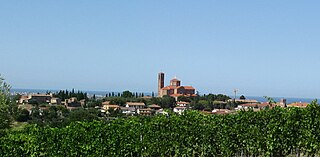
Coriano is a comune in the province of Rimini. This town is known for being the town of the Motorcycle World Champion, in 250cc class, Marco Simoncelli.

Sassofeltrio is a comune (municipality) in the Province of Rimini in the Italian region Emilia-Romagna, located about 145 kilometres (90 mi) southeast of Bologna and about 21 kilometres (13 mi) south of Rimini.
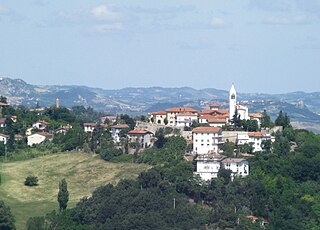
Gemmano is a comune (municipality) in the Province of Rimini in the Italian region Emilia-Romagna, located about 120 kilometres (75 mi) southeast of Bologna and about 15 km (9 mi) south of Rimini.
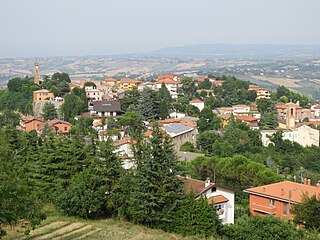
Montescudo is a frazione and former comune (municipality) in the Province of Rimini in the Italian region Emilia-Romagna, located about 120 kilometres (75 mi) southeast of Bologna and about 15 kilometres (9 mi) south of Rimini.

Morciano di Romagna is a comune (municipality) in the Province of Rimini in the Italian region Emilia-Romagna. It is about 120 kilometres (75 mi) southeast of Bologna and about 15 kilometres (9 mi) southeast of Rimini. The Conca flows past the town.

Louis Emanuel Jean Guy de Savoie-Carignan de Soissons CVO RA FRIBA (1890–1962) was the younger son of Charles de Savoie-Carignan, Count de Soissons. An architect, he was called for professional purposes Louis de Soissons.

The Battle of Rimini took place between 13 and 21 September 1944 during Operation Olive, the main Allied offensive on the Gothic Line in August and September 1944, part of the Italian Campaign in the Second World War. Rimini, a city on Italy's Adriatic coast, anchored the Rimini Line, a German defensive line which was the third such line of the Gothic Line defences.

The Old English Cemetery is a cemetery in Livorno (Leghorn), central Italy, located on a plot of land near the Via Verdi, close to the Waldensian Church and to the formerly Anglican church of St. George. It is the oldest Protestant cemetery in Italy.

The Conca is a river in the Marche and Emilia-Romagna regions of Italy. Its source is Monte Carpegna, which is in the Montefeltro part of the province of Pesaro e Urbino. The river flows northeast near Macerata Feltria and Mercatino Conca before crossing into the province of Rimini. The river then flows past Morciano di Romagna before entering the Adriatic Sea southeast of Misano Adriatico and northwest of Cattolica.

The German Futa Pass Cemetery is Italy's largest war cemetery. According to the German War Graves Commission it holds remains of 30,800 German soldiers who died in the Second World War. It is located at the summit of the Futa Pass in the Apennines and in Mugello, near Traversa in the commune of Firenzuola, that is, about 40 kilometers north of Florence and 40 kilometers south of Bologna along National Highway Nr. 65 near the border of Tuscany and Emilia-Romagna.
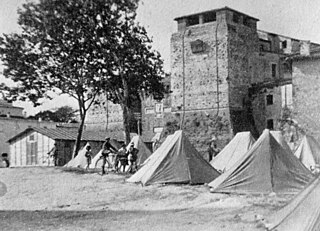
In 1916, two earthquakes of magnitude 5.82 occurred near the border between the regions of Romagna and the Marche in the Kingdom of Italy: at 13:50 CEST on 17 May, and at 09:06 CEST on 16 August.
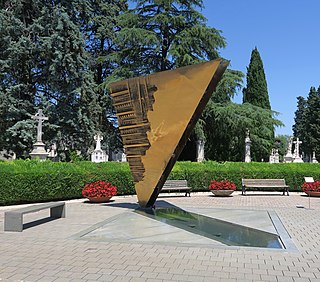
The Monumental Cemetery of Rimini, also known as the Civic Cemetery of Rimini, is the main cemetery in the city of Rimini, in the region of Emilia-Romagna, northern Italy.
The Villa des Vergers is a countryside villa in San Lorenzo in Correggiano, near Rimini, in the region of Emilia-Romagna, northern Italy. Dating to the 17th century, the villa was purchased by Adolphe Noël des Vergers in 1843, and substantially redesigned in 1879 by Arthur-Stanislas Diet. Between 1938 and 1946, it was owned by Mario Ruspoli, 2nd Prince of Poggio Suasa, who employed Pietro Porcinai to design the villa's gardens. The villa was used as a military headquarters by German forces in the Second World War, and has since been owned by a series of local entrepreneurs.




















